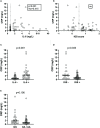C-Reactive Protein Levels in Systemic Lupus Erythematosus Are Modulated by the Interferon Gene Signature and CRP Gene Polymorphism rs1205
- PMID: 33584722
- PMCID: PMC7876312
- DOI: 10.3389/fimmu.2020.622326
C-Reactive Protein Levels in Systemic Lupus Erythematosus Are Modulated by the Interferon Gene Signature and CRP Gene Polymorphism rs1205
Abstract
Objectives: Patients with systemic lupus erythematosus (SLE) often display modest elevations of C-reactive protein (CRP) despite raised disease activity and increased interleukin (IL-) 6. We asked to what extent IL-6 levels, the CRP polymorphism rs1205, and the type I interferon (IFN) gene signature affects the basal CRP levels in patients with SLE during a quiescent phase of the disease.
Methods: CRP and IL-6 were analyzed in plasma from 57 patients meeting established classification criteria for SLE. The CRP polymorphism rs1205 was assessed and gene expression analyzed including four type I IFN-regulated genes (IGS).
Results: CRP was increased in patients with detectable IL-6 levels (p=0.001) and decreased among IGS-positive subjects (p=0.033). A multiple linear regression model revealed IL-6 to have a positive association with CRP levels, whereas both IGS-positivity and CRP genotype (rs1205) AA/GA were negatively associated with CRP-levels.
Conclusion: Our data offer an explanation to the modest CRP levels seen in viral infections and IFN-α driven autoimmunity and corroborate prior observations showing an IFN-α dependent downregulation of CRP. The latter observation, together with the fact that the CRP-lowering polymorphism rs1205 is overrepresented in human SLE, could explain low basal CRP and inadequate CRP-responses among patients with active SLE.
Keywords: C-reactive protein; biomarker; gene variants; inflammation; interferon; pentraxins; systemic lupus erythematosus; type I interferons.
Copyright © 2021 Enocsson, Gullstrand, Eloranta, Wetterö, Leonard, Rönnblom, Bengtsson and Sjöwall.
Conflict of interest statement
The authors declare that the research was conducted in the absence of any commercial or financial relationships that could be construed as a potential conflict of interest.
Figures


References
Publication types
MeSH terms
Substances
LinkOut - more resources
Full Text Sources
Other Literature Sources
Research Materials
Miscellaneous

